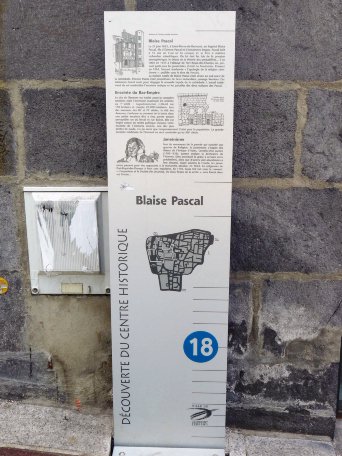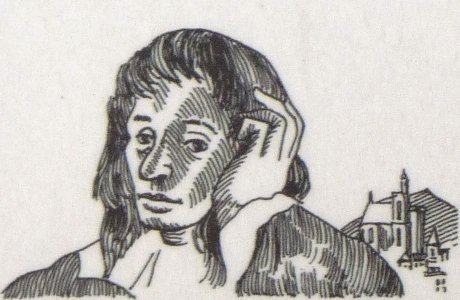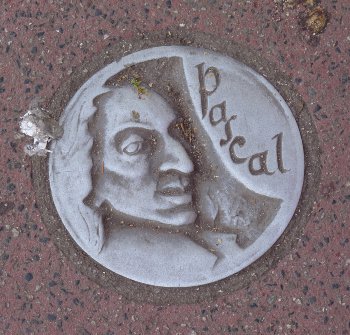 |  |
 |  |
![]() Durch die Altstadt von Clermont-Ferrand verläuft ein markierter Pfad, der die
Sehenswürdigkeiten dieser Stadt in Gestalt eines Stadtrundgangs verbindet. Der Verlauf
dieses Pfads ist mit Metallplättchen versehen, die unter anderem das Porträt von
B. Pascal zeigen (siehe die Darstellung am Ende dieser Seite). Die einzelnen Stationen des
Stadtrundgangs sind mit Informationstafeln versehen, so auch am Place Edmond
Lemaigre unmittelbar an der südwestlichen Ecke der Kathedrale Notre-Dame
de l'Assomption, die unter anderem auch auf den Mathematiker
Blaise
Pascal fokussiert. Auf dem zweiten Bild ist die Tafel zwischen Portal und dem linken
Schaufenster zu sehen.
Durch die Altstadt von Clermont-Ferrand verläuft ein markierter Pfad, der die
Sehenswürdigkeiten dieser Stadt in Gestalt eines Stadtrundgangs verbindet. Der Verlauf
dieses Pfads ist mit Metallplättchen versehen, die unter anderem das Porträt von
B. Pascal zeigen (siehe die Darstellung am Ende dieser Seite). Die einzelnen Stationen des
Stadtrundgangs sind mit Informationstafeln versehen, so auch am Place Edmond
Lemaigre unmittelbar an der südwestlichen Ecke der Kathedrale Notre-Dame
de l'Assomption, die unter anderem auch auf den Mathematiker
Blaise
Pascal fokussiert. Auf dem zweiten Bild ist die Tafel zwischen Portal und dem linken
Schaufenster zu sehen.
Der Text zu B. Pascal in französischer Sprache lässt sich wie folgt übersetzen:
| Blaise Pascal Am 27. Juni 1623 wurde Blaise Pascal - Sohn von Étienne Pascal und Antoinette Begon - in der Kirche Saint-Pierre-de-Clermont getauft. Mit 16 Jahren schrieb Pascal ein "Essay über die Kegelschnitte" und sein Buch über so manche wissenschaftliche Forschungen. Man verdankt ihm die Gesetze des atmosphärischen Drucks, die Anfänge der Wahrscheinlichkeitstheorie, ... . Im Jahr 1654 zog er sich zur Abtei Port-Royal-des-Champs zurück, wo er, das Leben mit den Janseniten teilend, "Briefe aus der Provinz"1) schrieb. Er starb 1662, die « Die Verteidigungsschrift der christlichen Religion » unvollendet lassend, veröffentlicht unter dem Titel "Gedanken". Das Geburtshaus von Blaise Pascal ist im Südwesten der Kathdrale gele- gen. Étienne Pascal gehörten die beiden Anwesen der Passage Vernines. Die Gebäude wurden abgerissen, um die neue Fassade der Kathedrale zu ermöglichen. Die aktuelle Struktur des Straßenpflasters zeichnet die Lage der antiken Stadtmauer und die Grundstücke der beiden Häuser der Pascals nach2). |
Die anderen Themen dieser Tafel mit dem Titel "Gebäude der vormaligen Passage Vernines" sind: Die Stadtmauer aus spätrömischer Zeit und Jansenismus3); zwei Themen, die im Text zu B. Pascal erwähnt werden. Die Tafel zeigt auch ein Porträt von B. Pascal, das dem auf der 500-Francs-Banknote, die im Jahr 1977 herausgegeben wurde, nachempfunden ist (siehe das Bild hinter der deutschsprachigen Beschreibung).
Die Fotos wurden im Mai 2012 von Joachim Rupp aus Erzhausen aufgenommen.
1) Die Übersetzung des Titels ist den Angaben in der Biographie von B. Pascal entlehnt. (Zurück zum Bezug)
2) Wenn man dies weiß sind diese Strukturen durchaus auch auf den Satellitenbildern von Google Maps zu erkennen. (Zurück zum Bezug)
3) Der Jansenismus ist eine religiös-sittliche Reformbewegung des nachtridentinischen Katholizismus in Frankreich im 17. und 18. Jahrhundert. Der Name dieser Erneuerungsbewegung geht auf den flämischen Theologen und Bischof von Ypern, Cornelius Jansen, zurück, insbesondere auf seine an Augustinus angelehnte Gnadenlehre (aus: Suchen: Jansenismus). (Zurück zum Bezug)

![]() There is a marked trail through the ancient city of Clermont-Ferrand which connects its
sights. This trail is marked with metal labels which show partially a portrait of B. Pascal
(confer the photograph at the end of this page). The different points of interest are
equipped with information boards. This is also the case at the Place Edmond Lemaigre
at the southwestern corner of the cathedral Notre-Dame de l'Assomption, which
among others focusses on the mathematician
Blaise
Pascal. On the second photograph above the tablet may be recognized between portal and
the left show-window.
There is a marked trail through the ancient city of Clermont-Ferrand which connects its
sights. This trail is marked with metal labels which show partially a portrait of B. Pascal
(confer the photograph at the end of this page). The different points of interest are
equipped with information boards. This is also the case at the Place Edmond Lemaigre
at the southwestern corner of the cathedral Notre-Dame de l'Assomption, which
among others focusses on the mathematician
Blaise
Pascal. On the second photograph above the tablet may be recognized between portal and
the left show-window.
The text concerning B. Pascal in French reads like:
| Blaise Pascal On June 27th, 1623 Blaise Pascal - son of Étienne Pascal and Antoinette Begon - was baptised in the church Saint-Pierre-de-Clermont. Aged 16 Pascal wrote an "Essay on conic sections" and his book on several scientific investigations. One owes to him the laws of atmospheric pressure, the basic ideas of propability theory, ... . In 1654 he drew back to the abbey Port-Royal-des-Champs, where he took part at the life with the Jansenists and wrote the "Provincial Letters"1). He died in 1662, leaving his « Apology on the Christian religion » unfinished, but published it with the title "thoughts". The birthplace of Blaise Pascal is located in the Southwest of the cathedral. Étienne Pascal owned both estates of the Passage Vernines. The buildings have been pulled down for the cathedral's new façade. The actual structure of the paving reconstructs the situation of the ancient town wall and Pascal's two houses2). |
The other topics of this tablet with its title "Buildings of the former Passage Vernines" are: The town wall from the late Roman age and Jansenism. Both topics are mentioned in the text for B. Pascal. The information board shows also a portrait of B. Pascal, which is similar to that on the 500 Francs banknote issued in 1977 (confer the picture between the German and the English description).
The photographs were taken in May 2012 by Joachim Rupp from Erzhausen.
1) The title is taken from B. Pascal's biography. (Back to the reference)
2) If one knows this, these structure may be recognized on the satellite's view of Google Maps. (Back to the reference)

| Back to the main page | Created by Wolfgang Volk in October 2012 |